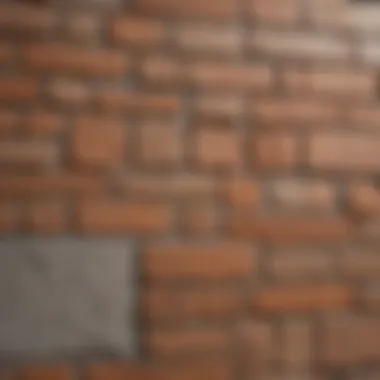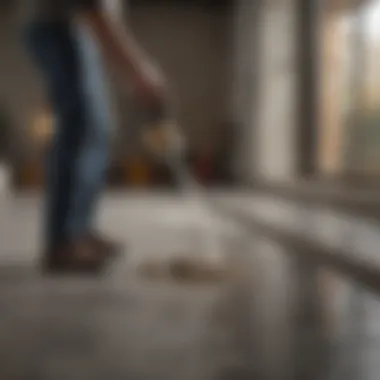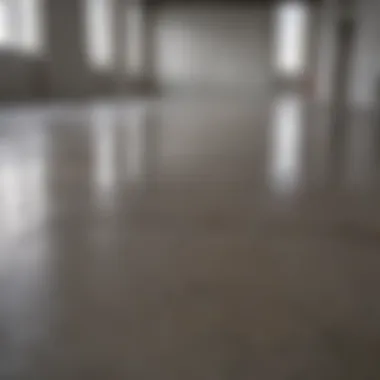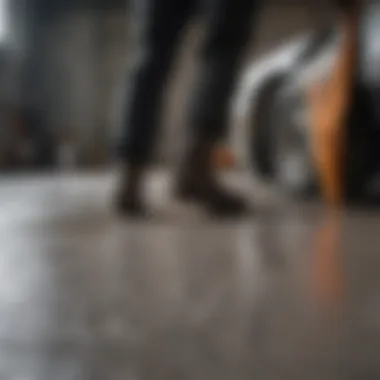Self-Leveling Concrete Techniques for Brick Surfaces


Overview of Topic
When considering flooring options, self-leveling concrete over brick presents a unique solution for those looking to enhance the aesthetic and functional aspects of their home. The process involves pouring a specialized mixture that can flow and settle into an even layer. Using self-leveling concrete on brick surfaces can transform an uneven or outdated floor into a smooth, modern surface ready for additional flooring materials, such as tile or hardwood.
Importance of the Topic
Understanding how to apply self-leveling concrete effectively is crucial for homeowners aiming to improve their living spaces efficiently. Unlike traditional concrete mixes, self-leveling compounds are designed to fill low spots and create a uniform surface with minimal effort. This characteristic is particularly important when dealing with older brick surfaces, which can often present challenges in terms of alignment and stability. Therefore, knowing the right techniques and considerations can lead to a successful and durable flooring solution.
Common Challenges and Solutions
Common Issues Faced by Homeowners
Several challenges often arise during the installation of self-leveling concrete on brick surfaces. Homeowners may face issues such as:
- Moisture in the Brick: Brick can retain moisture, which might affect the curing process and final integrity of the concrete.
- Surface Preparation: Insufficient preparation of the brick surface could lead to inadequate adhesion of the self-leveling compound, causing cracks over time.
- Cracking and Unevenness: If not applied correctly, self-leveling concrete may still end up uneven, negating the benefits it is meant to provide.
Solutions and Tips to Overcome These Challenges
To counter these challenges, homeowners should consider the following solutions:
- Ensure Proper Drying: Before starting the project, make sure the brick surface is completely dry. This may involve waiting several days after any cleaning operations.
- Thoroughly Clean the Surface: Remove loose debris, dirt, and dust from the brick to promote better adhesion. A pressure washer can help in some cases, but allow the brick to dry afterward.
- Use a Moisture Barrier: Applying a moisture barrier can prevent any residual dampness from affecting the self-leveling concrete.
Product Recommendations
Not all products are created equal. Selecting the right self-leveling concrete can affect the outcome significantly. Some industry-leading options include:
- Ardex K 15: This product is well-known for its easy application and strong adhesion qualities. It flows easily, allowing for an even surface.
- Mapei Self-Leveler Premium: This option is excellent for large areas and offers good compressive strength once cured.
- Henry 555 Level Pro: Known for its rapid curing time, this product can be a choice for those needing a quicker turnaround.
Benefits and Features of Recommended Products
Each of these products has unique benefits:
- Ardex K 15: Fast drying time and smooth finish.
- Mapei Self-Leveler Premium: High level of durability and can be applied in thickness up to 1 inch.
- Henry 555 Level Pro: Versatility in mixed environments, offering great performance in different temperatures.
Step-by-Step Guides
Practical Steps to Implement Improvements
- Prepare the Surface: Clean the entire brick area thoroughly and ensure it is dry.
- Apply a Primer: Use a suitable primer by following the manufacturer's instructions.
- Mix the Self-Leveling Compound: Prepare the self-leveling concrete mix according to the product guidelines. Make sure to mix it to the correct consistency.
- Pour the Mixture: Begin pouring the self-leveling concrete in one corner of the room, using a gauge rake to spread the material evenly across the surface.
- Allow to Cure: Follow the recommended curing times. Avoid any foot traffic until the product has completely set.
Detailed Instructions Where Necessary
Ensure to monitor the curing environment. Avoid drafts and maintain a steady temperature. Once cured, inspect for any inconsistencies and make necessary repairs before adding additional flooring materials.
Remember, a well-prepared surface is key to a successful self-leveling project.
Through understanding, preparation, and the use of the right products, homeowners can effectively apply self-leveling concrete over brick, ensuring longevity and improved aesthetics in their homes.
Understanding Self-Leveling Concrete
A foundational aspect of working with self-leveling concrete is comprehending what it entails. This understanding is critical not only for successful application over brick surfaces but also for achieving desired results in terms of durability and appearance. Self-leveling concrete serves as a solution to common issues faced with traditional concrete methods. Its ability to flow smoothly and create a flat surface presents significant advantages in flooring applications.
Definition and Composition
Self-leveling concrete is a specialized blend designed to create an even surface over irregular substrates. It consists of cement, aggregates, and various additives that enhance its flowability. Typically, it contains high-performance polymers that contribute to its adhesion and flexibility. When mixed with water, this compound exhibits a low viscosity, allowing it to fill voids and migrate into low areas effortlessly. This unique characteristic makes it particularly suitable for use over brick surfaces, which often present challenges due to their textured nature and configuration.
Benefits of Using Self-Leveling Concrete
Utilizing self-leveling concrete carries several benefits. Here are some of the most pertinent:


- Time Efficiency: The quick installation time is a significant advantage, allowing homeowners to continue with their projects with minimal delays.
- Smooth Finish: It provides a consistently smooth surface, which is crucial when laying tiles or other flooring materials subsequently.
- Reduced Labor Costs: Due to the ease of application, fewer skilled labor hours are required, leading to overall cost savings.
- Enhanced Durability: When properly applied, self-leveling concrete exhibits excellent resilience to wear and tear, making it appropriate for various types of foot traffic.
- Versatile Applications: Aside from flooring, it can also be employed for repairing substrates, filling gaps, and adjusting heights.
"Understanding the properties of self-leveling concrete is critical for ensuring a successful flooring project."
These benefits underscore the importance of understanding self-leveling concrete. When homeowners grasp its qualities and advantages, they are better positioned to make informed decisions about their flooring projects. This knowledge empowers them to evaluate where and how to apply these materials effectively.
Brick as a Substrate
Understanding the significance of brick as a substrate is essential for successful application of self-leveling concrete. Brick, as a building material, is favored for its longevity and aesthetic appeal. Yet, the characteristics intrinsic to brick bring both advantages and considerations that must be addressed when applying self-leveling compounds.
Characteristics of Brick
Brick is known for its durability. It can withstand significant pressure and is resistant to many environmental factors. One notable characteristic of brick is its porosity. This trait allows it to absorb moisture and settle, which can be crucial when addressing self-leveling concrete application. Furthermore, bricks provide a unique texture, adding visual interest to the surface once the self-leveling concrete is applied.
Another essential characteristic is the thermal mass of brick. This means that brick can absorb and store heat, which might influence the curing process of the self-leveling compound. The overall strength of the brick will also influence the amount of weight the new flooring can support. Thus, it is crucial for any homeowner to consider these characteristics when planning flooring over a brick substrate.
Challenges of Brick Surfaces
Despite the advantages, the brick substrate comes with inherent challenges. One primary issue is the unevenness commonly present in older brick surfaces. Even if bricks are laid correctly, over time, they may settle differently, creating imperfections. This can result in a poor finish once the self-leveling compound is applied. Uneven surfaces require meticulous preparation to ensure that the compound flows efficiently and creates a level surface.
Cracks in the bricks themselves can also pose challenges. These cracks can lead to issues of adhesion as well as future cracks in the self-leveling material. Repairing these cracks is crucial before proceeding with the application.
Lastly, moisture issues are another concern. Since bricks can hold moisture, it is essential to assess the moisture levels before application. If there is excess moisture, it will affect both the adhesion of the self-leveling compound and its curing process. Therefore, dealing with the challenges related to brick surfaces is as critical as leveraging its beneficial characteristics.
Preparation for Application
The process of applying self-leveling concrete over a brick surface demands meticulous preparation. Skipping this phase can lead to serious complications, such as poor adhesion, cracks, or an uneven finish. Preparation ensures that the self-leveling compound adheres properly to the substrate, leading to a successful flooring outcome. This phase is about laying the groundwork not only for the concrete application itself but for the long-term performance and durability of the flooring. The primary steps in the preparation for application are assessing the brick surface, cleaning it, repairing any damage, and finally, installing a moisture barrier.
Assessing the Brick Surface
Before any application begins, it is essential to carry out a thorough assessment of the brick surface. This task involves examining the bricks for structural integrity and existing issues like cracks or loose bricks. An uneven surface can significantly hinder the self-leveling compound from performing as expected. Inspect for areas that dip or rise, as these features will require attention. A flat and stable surface is necessary to achieve a durable finish. Understanding the condition of the brick allows for informed decisions on the subsequent preparation steps.
Cleaning the Brick Surface
Once the assessment is complete, the next step is cleaning the brick surface. Dust, grease, and other contaminants can obstruct the bonding process, leading to detachment or failure of the self-leveling concrete. Begin by sweeping to remove loose dirt and debris. A pressure washer can then be utilized to eliminate stubborn grime. If mold, mildew, or chemical residues are present, a mild detergent solution may be necessary. Ensure the surface is thoroughly rinsed and left to dry, as moisture can affect the bonding of subsequent materials.
Repairing Damaged Areas
Repairing damaged areas is critical for a successful application. Any cracks or loose bricks should be addressed before applying the self-leveling compound. Fill cracks with an appropriate repair material, such as a concrete repair caulk or mortar. This step not only improves the surface's flatness but also prevents further damage from occurring over time. Evaluate the overall condition and make necessary repairs to avoid issues in the future. It is crucial to allow repairs to cure according to the manufacturer's specifications for optimal results.
Installing a Moisture Barrier
Lastly, installing a moisture barrier is a vital precaution. Brick can retain moisture, and if this moisture is not controlled, it can lead to problems with the self-leveling compound. A moisture barrier effectively prevents water from penetrating through the brick surface, ensuring longevity and performance of the flooring. Products like polyethylene sheets or liquid applied membranes can be used for this purpose. Follow the manufacturer's instructions for proper application technique. A properly installed moisture barrier can save time, money, and effort by reducing the risk of future complications.
Remember: Proper preparation is non-negotiable. Rushing this phase can lead to costly repairs and subpar results.
Selecting the Right Self-Leveling Compound
Choosing the correct self-leveling compound is an essential step in the process of applying self-leveling concrete over brick surfaces. The right material will not only help overcome the challenges posed by the inherent characteristics of brick but also affect the performance and longevity of the final flooring solution. Selecting the right compound ensures both optimal adhesion and durability, crucial factors in any flooring project. This section will explore the various types of self-leveling compounds available and the factors to consider when making this decision.
Types of Self-Leveling Compounds
There are several types of self-leveling compounds, each designed for specific applications and conditions. Understanding these categories is vital in order to choose an appropriate compound for brick surfaces:
- Cement-Based Compounds: These are the most common options. They typically consist of cement, aggregates, and additives that enhance flow and leveling properties. Cement-based compounds are suitable for interior and exterior applications, providing good strength and durability.
- Gypsum-Based Compounds: These are lighter and easier to work with compared to cement-based options. They set quickly and are ideal for interior applications. However, they should not be used in areas prone to moisture, as they lack water resistance.
- Polymer-Modified Compounds: These compounds include additives that improve bonding and flexibility. They are excellent for high-traffic areas and can support various floor coverings. Their enhanced performance often comes at a higher cost.
- Self-Leveling Epoxy Systems: These are highly durable and can resist chemical exposure. While expensive, they provide excellent performance in industrial settings or areas subjected to heavy wear and moisture.
Understanding the unique benefits and limitations of each type of compound will guide homeowners in making an informed decision, ensuring their project achieves the intended results.
Factors to Consider


When selecting a self-leveling compound, several critical factors should be evaluated:
- Moisture Conditions: Brick is often porous, which means moisture can be an issue. The compound must have sufficient water resistance if there is a risk of moisture seeping through.
- Thickness Requirements: Different projects may have varying thickness needs. It's important to choose a compound that can be applied at the required thickness without risking structural integrity.
- Curing Time: Some compounds set quickly, while others take longer. Depending on the project timeline, this can play a significant role in your choice.
- Bonding Strength: A compound with strong bonding properties will help ensure a secure connection between the self-leveling layer and the underlying brick.
- Environmental Impact: Consider the environmental aspects of the selected compound, including its sustainability and longevity. Opt for products that adhere to modern eco-friendly standards.
- Cost: Lastly, factor in your budget. Different compounds come at various price points, and understanding what fits into your financial plan without compromising quality is important.
Tip: Consider consulting with a flooring expert to get recommendations tailored to your specific project needs. They often can provide insights based on experience and help avoid common pitfalls during application.
By carefully evaluating these factors and understanding the types of self-leveling compounds available, homeowners can select the best option for achieving a robust and aesthetically pleasing flooring solution over brick surfaces.
Application Techniques
The application techniques of self-leveling concrete are pivotal in ensuring a successful flooring project over brick surfaces. These techniques not only determine the aesthetic and functional quality of the final floor but also influence durability and maintenance in the long run. Proper application is crucial since it can significantly mitigate common issues such as cracking or inadequate adhesion. By understanding and following the correct methods for mixing, pouring, and finishing the concrete, homeowners can achieve a level surface that meets their design and functional expectations.
Mixing the Self-Leveling Compound
Mixing is the first and very important step when applying self-leveling concrete. The compound’s consistency and uniformity will directly affect its performance after application. To start, select a clean mixing container. Using a drill with a mixing paddle can facilitate an even blend, ensuring that both powdered and liquid components combine thoroughly.
Follow the manufacturer’s specified water-to-powder ratio. Adding too much water can weaken the mixture; too little can lead to inadequate flow. Once mixed, it is important to use the compound promptly as it can begin to set quickly. Make sure to mix only what you can pour within the working time indicated on the packaging.
Remember, the key to a successful mixture is following the manufacturer’s guidelines precisely.
Pouring the Compound
Once you have prepared the mixture, the next step is pouring. This process requires careful execution to ensure an even application over the vast area. Start pouring at one end of the room, allowing the compound to flow naturally into low spots and crevices. It is important to maintain a consistent pace. Rushing the pour can compromise the work by introducing air bubbles or causing uneven areas.
While pouring, ensure the area is free of obstructions to allow smooth movement. Using a gauge rake during this phase can help in spreading the compound evenly across the surface. The goal is to achieve an even thickness that complies with the requirement for your specific project.
Using Spiked Rollers
After pouring the self-leveling compound, the use of spiked rollers becomes essential. Spiked rollers help in eliminating air bubbles that may have trapped during mixing or pouring. By rolling the compound gently but consistently, you increase the compound’s density and promote better adhesion to the brick.
Ensure that you use a roller with spikes that are long enough to penetrate the surface but not so long that they disturb the compound too much. Timing with the spiked roller is critical; this should occur shortly after the compound has been poured but before it fully sets. This technique can contribute significantly to the longevity and effectiveness of the flooring system.
In summary, mastering these application techniques is critical for achieving optimal results when applying self-leveling concrete over brick. Each step requires attention to detail and adherence to best practices to ensure that the final surface is not only functional but also visually appealing.
Curing and Finishing
Curing and finishing are critical steps in the application of self-leveling concrete over brick surfaces. Proper curing enhances the strength and durability of the concrete, while finishing ensures a smooth and visually appealing surface. When done correctly, these processes contribute significantly to the long-term performance and aesthetics of the flooring.
Curing Guidelines
Curing refers to the process of maintaining adequate moisture, temperature, and time for the concrete to properly hydrate and gain strength. Here are some essential guidelines for curing self-leveling concrete:
- Duration: Curing should start immediately after the self-leveling compound has set, generally within 30 minutes post-application. Maintain moisture for at least 24 to 72 hours, depending on the specific product used.
- Moisture Retention: Use wet burlap, plastic sheeting, or curing compounds to prevent the surface from drying out too quickly. This controlled environment is vital for optimal curing conditions.
- Temperature Control: Avoid exposing the surface to extreme hot or cold conditions. Ideal curing temperatures typically range from 50°F to 85°F (10°C to 30°C). If conditions are extreme, consider using heaters or insulation to maintain stable temperatures.
- Avoid Traffic: Avoid foot and vehicle traffic on the newly leveled floor until the curing period is complete. This reduces the risk of damage and ensures the integrity of the surface.
"Proper curing not only affects the initial strength of the concrete but also ensures long-term performance and minimizes issues such as cracking and surface imperfections."
Post-Application Maintenance
Once the curing period is complete, maintaining the surface is crucial to ensure its longevity and appearance.
- Initial Cleaning: After curing, clean the surface to remove any dust or debris. A damp mop can be used for this, but avoid excess water, which can affect the concrete.
- Regular Inspections: Check the floor periodically for signs of wear or damage. Early detection of surface issues can help prevent more significant problems down the line.
- Sealing: Consider applying a suitable sealer to protect the surface from moisture and staining. This can enhance the durability and maintain the appearance of the floor while preventing issues like mold or mildew.
- Routine Maintenance: Regular sweeping and mopping will keep the floor looking fresh. Avoid using harsh chemicals that can damage the surface; instead, opt for gentle cleaners designed for concrete.
- Temperature and Humidity Monitoring: Be aware of changes in indoor climate. Extreme fluctuations can affect the concrete. Maintain consistent indoor conditions to prolong the life of the flooring.
Following these guidelines for curing and post-application maintenance will ensure that the self-leveling concrete not only looks good but also stands the test of time, providing a reliable surface over your brick substrate.
Potential Challenges
Understanding the potential challenges associated with self-leveling concrete over brick surfaces is crucial for ensuring a successful project. These challenges include issues such as cracking and shrinkage, along with adhesion problems. Both of these aspects can negatively affect the longevity and performance of the flooring. By acknowledging these potential issues ahead of time, homeowners can take appropriate measures to prevent them, ultimately enhancing the project's success.
Cracking and Shrinkage


Cracking and shrinkage are common challenges when working with self-leveling concrete. The nature of concrete changing as it cures can cause it to pull away from the substrate, especially if the underlying brick lacks a solid, uniform surface. Cracks may form as the concrete dries, largely influenced by ambient conditions like temperature and humidity. It's important to note that while minor cracking can sometimes be acceptable, excessive cracking can lead to severe structural and aesthetic problems.
To mitigate the risk of cracking, proper preparation of the brick surface is essential. Any irregularities, such as holes or unstable bricks, should be repaired beforehand. The use of a suitable moisture barrier can also help regulate moisture levels, further reducing the likelihood of cracking. It is wise to continuously monitor temperature and humidity during the curing process for optimal results. Adequately conditioned environments will yield a more stable finished product.
Adhesion Issues
Adhesion issues can arise when the self-leveling concrete does not bond properly to the brick substrate. This situation often leads to delamination, where the surface layer detaches from the underlying material. Such issues can arise from the presence of dust, grease, or moisture on the brick surface. If the self-leveling compound does not adhere well, the entire flooring system can fail.
To prevent adhesion problems, meticulous cleaning of the brick surface is necessary. This should be done using appropriate cleaning solutions to remove all contaminants. Additionally, applying a primer specifically designed for self-leveling concrete will enhance the bond between the compound and the brick. Ensuring the surface is completely dry before application is also crucial in maintaining proper adhesion.
By recognizing and addressing these potential challenges, homeowners can significantly increase their chances of a successful self-leveling concrete installation. Monitoring conditions and preparing the surface diligently can create a more durable and visually appealing floor.
Long-Term Performance
Long-term performance is a crucial aspect when considering self-leveling concrete over brick. It not only relates to the durability of the surface but also encompasses several factors that contribute to the overall functionality and aesthetic appeal of the flooring. In this section, we will explore important elements of long-term performance, its benefits, and considerations that homeowners should keep in mind.
Durability Factors
When applying self-leveling concrete over bricks, durability becomes a key priority. The longevity of the flooring is impacted by many factors:
- Material Quality: Utilize high-quality self-leveling compounds specifically designed for durability. Products from brands like Mapei and Ardex can offer superior performance compared to generic options.
- Surface Preparation: Properly preparing the brick surface ensures that the self-leveling concrete adheres well and withstands wear over time. Any missed cracks or dirt can lead to premature failure.
- Moisture Control: Bricks can absorb moisture, which may affect the self-leveling concrete. Installing a moisture barrier during preparation can greatly enhance durability.
- Environmental Impact: Changes in humidity and temperature can stress the concrete. Consideration of the local climate can impact how the concrete behaves long-term.
Attention to these factors can lead to a surface that remains functional and visually appealing for many years.
Maintenance Practices
Maintenance is often overlooked when discussing long-term performance. Regular upkeep can significantly extend the life of the flooring:
- Regular Cleaning: Dust and dirt can accumulate on the surface. A simple routine of sweeping and mopping with a gentle cleaner can prevent buildup and maintain aesthetics.
- Inspection for Damage: Periodically check for signs of wear, such as cracks or discoloration. Early detection can prevent larger issues later.
- Reapplication of Sealant: Depending on the level of foot traffic and exposure, a reapplication of a sealant may be necessary every few years to protect the surface and maintain its appearance.
- Avoiding Excessive Water: Limit the use of water for cleaning. Standing water can penetrate joints and cause damage over time.
Environmental Considerations
Environmental considerations play a crucial role in any construction project, including the application of self-leveling concrete over brick. Understanding these factors not only influences the sustainability of the project but also affects long-term performance and the overall impact on the environment. Each step within this process should be evaluated with a focus on eco-friendliness, resource conservation, and waste management.
Material Sustainability
When selecting materials for a flooring project, it is essential to prioritize sustainable options. Self-leveling concrete can be more eco-friendly when made from recycled aggregates or additives that reduce its carbon footprint. For example, products that incorporate fly ash or slag help in minimizing the amount of Portland cement needed.
Using these materials can contribute to more sustainable construction practices. Moreover, choosing brands with transparent environmental policies emphasizes the importance of reducing environmental impact.
Benefits of sustainable materials include the following:
- Reduced carbon emissions: Lower usage of Portland cement leads to a smaller carbon footprint.
- Energy efficiency: Materials that require less energy to produce often contribute to overall energy savings.
- Encouraging recycling: Utilizing recycled materials can decrease landfill waste and promote a circular economy.
Disposal of Old Materials
Proper disposal of old materials is critical in maintaining environmental responsibility during the renovation process. Brick surfaces may have to be stripped or replaced, resulting in waste that requires careful consideration in terms of disposal.
Some important points to consider for disposing of old materials include:
- Recycling opportunities: Before discarding old bricks or concrete, assess the potential for recycling. Many local construction material suppliers may accept old bricks for reuse.
- Hazardous materials: Be aware that some old materials may be harmful. This could include asbestos in specific older finishes or lead paint. Proper assessment is necessary to handle these materials correctly.
- Local regulations: Complying with local laws regarding waste disposal ensures that hazardous or non-recyclable materials are disposed of correctly, thus protecting the environment.
In summary, by emphasizing environmental considerations in self-leveling concrete projects, homeowners can ensure a more sustainable renovation that minimizes waste and conserves resources. Choosing sustainable materials and properly disposing of old materials fosters not just personal responsibility but contributes to a healthier planet.
End
In any flooring project, particularly when dealing with self-leveling concrete over a brick substrate, the conclusion serves as a vital summary and reflection of the journey undertaken. The importance of this section is multifaceted; it consolidates the critical insights shared throughout the article while reinforcing the primary techniques and considerations necessary for a successful application.
First, it highlights the significant preparatory steps. This involves assessing the brick's condition, ensuring its cleanliness, and potentially installing a moisture barrier. Proper preparation cannot be overstated, as it lays the groundwork for the entire project’s success. If these initial actions are neglected, the risks for future challenges, such as cracking or poor adhesion, increase exponentially. Moreover, selecting the appropriate self-leveling compound based on specific conditions of the brick surface is crucial.
Additionally, the conclusion emphasizes the need for meticulous application techniques. Mixing, pouring, and using spiked rollers should be approached with attention to detail to guarantee even distribution and optimal results. After application, understanding the curing process and proper maintenance will lead to durability and longevity in the finished product. The reader should feel empowered with knowledge about how to maintain and enjoy the results of their project, understanding that ongoing care contributes significantly to the floor's lifespan.
Finally, the environmental considerations discussed throughout the article transcend mere compliance; they signify a commitment to sustainable practices. Being mindful of material sustainability and appropriate disposal methods for old materials not only satisfies regulatory requirements but also promotes a healthier living environment.
In summary, the conclusion does more than provide a wrap-up; it acts as a vital checkpoint for housewives and homeowners alike to assimilate the knowledge gained, ultimately leading to a successful flooring venture using self-leveling concrete over brick.







